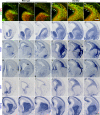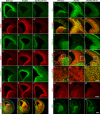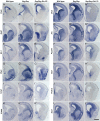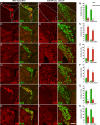Dlx1/2 are Central and Essential Components in the Transcriptional Code for Generating Olfactory Bulb Interneurons
- PMID: 30796806
- PMCID: PMC6917526
- DOI: 10.1093/cercor/bhz018
Dlx1/2 are Central and Essential Components in the Transcriptional Code for Generating Olfactory Bulb Interneurons
Abstract
Generation of olfactory bulb (OB) interneurons requires neural stem/progenitor cell specification, proliferation, differentiation, and young interneuron migration and maturation. Here, we show that the homeobox transcription factors Dlx1/2 are central and essential components in the transcriptional code for generating OB interneurons. In Dlx1/2 constitutive null mutants, the differentiation of GSX2+ and ASCL1+ neural stem/progenitor cells in the dorsal lateral ganglionic eminence is blocked, resulting in a failure of OB interneuron generation. In Dlx1/2 conditional mutants (hGFAP-Cre; Dlx1/2F/- mice), GSX2+ and ASCL1+ neural stem/progenitor cells in the postnatal subventricular zone also fail to differentiate into OB interneurons. In contrast, overexpression of Dlx1&2 in embryonic mouse cortex led to ectopic production of OB-like interneurons that expressed Gad1, Sp8, Sp9, Arx, Pbx3, Etv1, Tshz1, and Prokr2. Pax6 mutants generate cortical ectopia with OB-like interneurons, but do not do so in compound Pax6; Dlx1/2 mutants. We propose that DLX1/2 promote OB interneuron development mainly through activating the expression of Sp8/9, which further promote Tshz1 and Prokr2 expression. Based on this study, in combination with earlier ones, we propose a transcriptional network for the process of OB interneuron development.
Keywords: Ascl1, Pax6; Dlx1; Dlx2; Gsx2; Sp8; Sp9; interneuron; olfactory bulb.
© The Author(s) 2019. Published by Oxford University Press. All rights reserved. For Permissions, please e-mail: journals.permissions@oup.com.
Figures










Similar articles
-
Transcription Factors Sp8 and Sp9 Coordinately Regulate Olfactory Bulb Interneuron Development.Cereb Cortex. 2018 Sep 1;28(9):3278-3294. doi: 10.1093/cercor/bhx199. Cereb Cortex. 2018. PMID: 28981617 Free PMC article.
-
Septal contributions to olfactory bulb interneuron diversity in the embryonic mouse telencephalon: role of the homeobox gene Gsx2.Neural Dev. 2017 Aug 16;12(1):13. doi: 10.1186/s13064-017-0090-5. Neural Dev. 2017. PMID: 28814342 Free PMC article.
-
A subpopulation of olfactory bulb GABAergic interneurons is derived from Emx1- and Dlx5/6-expressing progenitors.J Neurosci. 2007 Jun 27;27(26):6878-91. doi: 10.1523/JNEUROSCI.0254-07.2007. J Neurosci. 2007. PMID: 17596436 Free PMC article.
-
Transcriptional Regulation of Cortical Interneuron Development.In: Noebels JL, Avoli M, Rogawski MA, Vezzani A, Delgado-Escueta AV, editors. Jasper's Basic Mechanisms of the Epilepsies. 5th edition. New York: Oxford University Press; 2024. Chapter 47. In: Noebels JL, Avoli M, Rogawski MA, Vezzani A, Delgado-Escueta AV, editors. Jasper's Basic Mechanisms of the Epilepsies. 5th edition. New York: Oxford University Press; 2024. Chapter 47. PMID: 39637134 Free Books & Documents. Review.
-
Transcriptional regulation of olfactory bulb neurogenesis.Anat Rec (Hoboken). 2013 Sep;296(9):1364-82. doi: 10.1002/ar.22733. Epub 2013 Jul 31. Anat Rec (Hoboken). 2013. PMID: 23904336 Review.
Cited by
-
Identifying gene expression profiles associated with neurogenesis and inflammation in the human subependymal zone from development through aging.Sci Rep. 2022 Jan 7;12(1):40. doi: 10.1038/s41598-021-03976-4. Sci Rep. 2022. PMID: 34997023 Free PMC article.
-
A comparative view of human and mouse telencephalon inhibitory neuron development.Development. 2025 Jan 1;152(1):dev204306. doi: 10.1242/dev.204306. Epub 2025 Jan 2. Development. 2025. PMID: 39745314 Review.
-
Spatial transcriptomics reveals human cortical layer and area specification.Nature. 2025 Aug;644(8075):153-163. doi: 10.1038/s41586-025-09010-1. Epub 2025 May 14. Nature. 2025. PMID: 40369074 Free PMC article.
-
Pax6 limits the competence of developing cerebral cortical cells to respond to inductive intercellular signals.PLoS Biol. 2022 Sep 6;20(9):e3001563. doi: 10.1371/journal.pbio.3001563. eCollection 2022 Sep. PLoS Biol. 2022. PMID: 36067211 Free PMC article.
-
Olfactory bulb interneurons - The developmental timeline and targeting defined by embryonic neurogenesis.Mol Cell Neurosci. 2025 Jun;133:104007. doi: 10.1016/j.mcn.2025.104007. Epub 2025 Mar 22. Mol Cell Neurosci. 2025. PMID: 40122272
References
-
- Allen ZJ 2nd, Waclaw RR, Colbert MC, Campbell K. 2007. Molecular identity of olfactory bulb interneurons: transcriptional codes of periglomerular neuron subtypes. J Mol Histol. 38:517–525. - PubMed
-
- Alvarez-Buylla A, Kohwi M, Nguyen TM, Merkle FT. 2008. The heterogeneity of adult neural stem cells and the emerging complexity of their niche. Cold Spring Harb Symp Quant Biol. 73:357–365. - PubMed
-
- Anderson SA, Qiu M, Bulfone A, Eisenstat DD, Meneses J, Pedersen R, Rubenstein JL. 1997. Mutations of the homeobox genes Dlx-1 and Dlx-2 disrupt the striatal subventricular zone and differentiation of late born striatal neurons. Neuron. 19:27–37. - PubMed
-
- Bartolini G, Ciceri G, Marin O. 2013. Integration of GABAergic interneurons into cortical cell assemblies: lessons from embryos and adults. Neuron. 79:849–864. - PubMed
Publication types
MeSH terms
Substances
Grants and funding
LinkOut - more resources
Full Text Sources
Molecular Biology Databases
Research Materials
Miscellaneous

